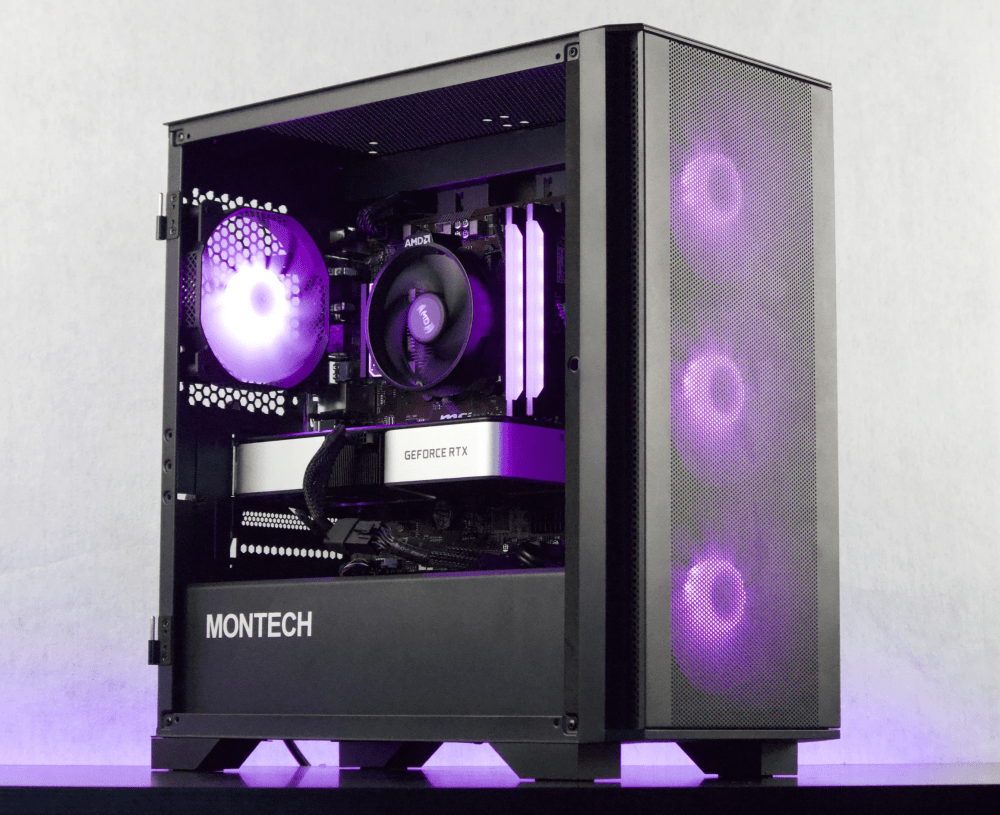Welcome to our step-by-step guide on installing a CPU cooler! Whether you're a seasoned computer enthusiast or a beginner looking to upgrade your system, understanding how to properly install a CPU cooler is essential for maintaining optimal performance and preventing overheating.
In this blog post, we will break down the installation process into easy-to-follow sections. We'll start by explaining the importance of having a CPU cooler and the reasons why proper installation is necessary. Then, we'll go over the supplies you'll need and how to prepare your working space.
Next, we'll dive into the installation process itself. We'll walk you through applying thermal paste, fitting the cooler onto the CPU, and securing it in place. We'll also guide you on connecting the CPU cooler to the motherboard, ensuring a secure connection that will keep your system running smoothly.
Lastly, we'll provide you with a post-installation checklist. This will include checking for proper installation, booting up your computer to test functionality, and monitoring CPU temperature to ensure everything is working as it should be.
By the end of this guide, you'll have the knowledge and confidence to install a CPU cooler with ease, allowing you to enjoy improved thermal management and better overall performance for your computer. So, without further ado, let's get started on this exciting journey of CPU cooler installation!
Understanding the Basics: Why You Need a CPU Cooler
The CPU (Central Processing Unit) is the brain of your computer, responsible for executing instructions and performing calculations. As it carries out these tasks, it generates heat. Without proper cooling, the CPU can quickly overheat, leading to reduced performance, instability, and even permanent damage.
This is where a CPU cooler comes into play. A CPU cooler is a device designed to dissipate the heat generated by the CPU, keeping it within safe temperature limits. It consists of a heatsink, which absorbs the heat, and a fan (or fans) that blows air across the heatsink to carry away the heat.
There are several reasons why you need a CPU cooler:
-
Temperature Regulation: A CPU cooler helps maintain the optimal operating temperature for your CPU. Excessive heat can cause the CPU to throttle its performance or even shut down to prevent damage.
-
Longevity and Reliability: By keeping the CPU temperature in check, a cooler helps extend the lifespan of your processor. Heat is one of the primary factors that can degrade the longevity of electronic components.
-
Overclocking Potential: Overclocking is the process of running your CPU at higher frequencies than its default settings, allowing for increased performance. However, overclocking generates more heat, making a robust CPU cooler crucial for stability and preventing damage.
-
Quiet Operation: Some CPU coolers are designed for silent operation, minimizing fan noise while effectively cooling the CPU. This ensures a quieter computing experience, especially during intensive tasks.
Now that you understand the importance of having a CPU cooler, let's move on to the next section, where we will discuss the preparations you need to make before installing the cooler.
Preparation for CPU Cooler Installation
Before diving into the installation process, it's crucial to make the necessary preparations. Taking the time to prepare your working space and gather the required supplies will ensure a smooth and hassle-free installation of your CPU cooler. Let's explore the essential steps you need to follow:
Why Proper Installation is Necessary
Proper installation of a CPU cooler is vital for several reasons:
-
Optimal Cooling Efficiency: Installing the CPU cooler correctly ensures that it makes proper contact with the CPU, allowing for efficient heat transfer and dissipation.
-
Preventing Damage: Incorrect installation can result in poor thermal contact or even physical damage to the CPU or motherboard. Proper installation minimizes the risk of damage during the process.
-
Warranty Preservation: Many CPU coolers come with warranties, and improper installation may void these warranties. Following the correct installation procedure ensures you can take advantage of any warranty coverage if needed.
Supplies Needed for Installation
Before starting the installation process, gather the following supplies:
-
CPU Cooler: Choose a CPU cooler that is compatible with your CPU socket type and offers the cooling performance you require. It's essential to check the specifications and compatibility of the cooler with your motherboard and CPU.
-
Thermal Paste: Thermal paste is a crucial component that helps improve heat transfer between the CPU and the cooler. Ensure you have a high-quality thermal paste to apply during the installation process.
-
Screwdriver: Depending on the CPU cooler model, you may need a screwdriver to secure the cooler in place. Check the manufacturer's instructions to determine the type of screwdriver required.
-
Rubbing Alcohol and Lint-Free Cloth: These materials are necessary to clean the CPU and remove any existing thermal paste before applying a fresh layer. Make sure you have rubbing alcohol (isopropyl alcohol) and a lint-free cloth for this task.
Preparing Your Working Space
Creating a suitable working environment is essential for a smooth installation. Follow these steps to prepare your working space:
-
Clean and Clear Workspace: Clear your workspace of any clutter or objects that may hinder the installation process. Ensure you have enough space to work comfortably.
-
Static Electricity Precautions: Static electricity can potentially damage sensitive computer components. To prevent this, work on a non-static surface, such as an anti-static mat or a wooden table. Additionally, it is recommended to wear an anti-static wrist strap during the installation process.
-
Proper Lighting: Ensure that your workspace is well-lit, allowing you to see all the components clearly. This will help you navigate the installation process more effectively.
Now that you are prepared with the necessary supplies and have set up your working space, we are ready to move on to the next section: Installing the CPU cooler.
Installing the CPU Cooler
Now that you have prepared your working space and gathered the necessary supplies, it's time to dive into the installation process of your CPU cooler. Follow these step-by-step instructions to ensure a successful installation:
Applying Thermal Paste
-
Clean the CPU: Start by cleaning the CPU surface using a lint-free cloth and rubbing alcohol. This will remove any existing thermal paste or debris.
-
Apply Thermal Paste: Apply a small amount of thermal paste onto the center of the CPU. The paste should be spread in a thin, even layer using a plastic applicator or the thermal paste syringe itself. Be careful not to use too much paste, as it can lead to poor heat transfer or spillage.
Fitting the Cooler onto the CPU
-
Identify Cooler Orientation: Examine your CPU cooler to determine the correct orientation for installation. Most coolers have an arrow or marking indicating the direction of airflow.
-
Align the Cooler: Carefully place the cooler on top of the CPU, ensuring that the mounting holes on the cooler align with the corresponding holes on the motherboard. Take note of any brackets or mounting mechanisms provided by the cooler manufacturer.
-
Secure the Cooler: Depending on the cooler model, use the provided screws or mounting brackets to secure the cooler in place. Use a screwdriver to tighten the screws evenly in a diagonal pattern, ensuring that the pressure is distributed evenly across the CPU.
Securing the Cooler
-
Check Firmness: Once the cooler is securely attached, gently wiggle it to ensure it is properly seated and firmly attached to the CPU. This step helps verify that there is sufficient contact between the cooler and the CPU.
-
Check Clearance: Ensure that the CPU cooler does not interfere with any nearby components, such as RAM modules or PCIe slots. Make any necessary adjustments to ensure sufficient clearance.
Congratulations! You have successfully installed your CPU cooler. Now, let's move on to the next section where we will guide you on connecting the CPU cooler to the motherboard.
Connecting the CPU Cooler to the Motherboard
Now that the CPU cooler is securely installed, it's time to connect it to the motherboard. This step is crucial for the cooler to function properly and ensure efficient cooling of your CPU. Follow these steps to connect the CPU cooler to the motherboard:
Locating the Proper Connector on the Motherboard
-
Refer to the Motherboard Manual: Consult the motherboard manual to locate the specific connector designated for the CPU cooler. This connector is typically labeled "CPU_FAN" or "CPU_OPT" and is usually located near the CPU socket.
-
Identify the CPU Cooler Cable: Locate the cable coming from the CPU cooler fan. This cable usually has a 3 or 4-pin connector, depending on the type of fan.
Plugging in the Cooler
-
Align the Connector: Align the connector on the CPU cooler cable with the corresponding pins on the motherboard's CPU cooler connector. Ensure that the pins and notches are properly aligned before inserting the connector.
-
Insert the Connector: Gently insert the CPU cooler connector into the motherboard's CPU cooler connector. Apply even pressure to ensure a secure connection.
Ensuring Secure Connection
-
Check for a Click or Locking Mechanism: Some motherboard connectors have a locking mechanism that secures the connector in place. Verify that the connector is securely locked into position.
-
Verify Connection: Double-check the connection by gently tugging on the CPU cooler cable. It should be firmly attached and not come loose easily.
Congratulations! You have successfully connected your CPU cooler to the motherboard. Now, let's move on to the next section where we will provide you with a post-installation checklist to ensure everything is in order.
Post-Installation Checklist
After successfully installing and connecting your CPU cooler, it's important to perform a post-installation checklist to ensure everything is functioning properly. This checklist will help you verify the installation, test the functionality, and monitor the CPU temperature. Follow these steps to complete the post-installation checklist:
Checking for Proper Installation
-
Visual Inspection: Carefully inspect the CPU cooler to ensure it is securely attached to the CPU and there are no loose screws or brackets.
-
Clearance Check: Verify that there is sufficient clearance between the CPU cooler and nearby components, such as RAM modules or PCIe slots.
Booting the Computer to Check Functionality
-
Power On: Turn on your computer and observe the boot process.
-
Monitor Fan Operation: Keep an eye on the CPU cooler fan(s) to ensure they are spinning properly. Abnormal noises or lack of movement may indicate an issue.
-
Enter BIOS: Access the BIOS of your computer and navigate to the hardware monitoring section. Verify that the CPU temperature is within the normal range.
Monitoring CPU Temperature
-
Download Monitoring Software: Install a CPU temperature monitoring software such as Core Temp, HWMonitor, or SpeedFan.
-
Monitor Temperature: Run the monitoring software and keep an eye on the CPU temperature during different tasks, such as idle, web browsing, or running demanding applications. Ensure that the temperature remains within safe operating limits.
-
Troubleshooting: If you notice excessively high temperatures or abnormal temperature fluctuations, double-check the installation, ensure proper contact between the CPU and cooler, and consider reapplying thermal paste if necessary.
By completing this post-installation checklist, you can ensure that your CPU cooler is installed correctly, functioning properly, and effectively managing the temperature of your CPU. If any issues arise during the checklist, refer back to the relevant steps to troubleshoot and resolve them.
With the installation complete and the post-installation checklist done, you can now enjoy improved thermal management and optimal performance from your CPU cooler. Happy computing!
Looking to upgrade your CPU cooler? Check out Jawa for killer deals on new and used cooling systems.





